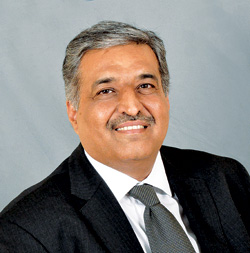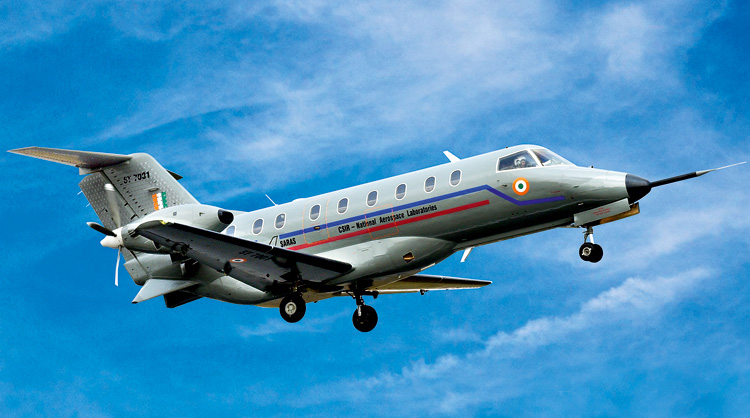- Prime Minister Narendra Modi inaugurates Aero India 2023 in Bengaluru; Releases Commemorative Stamp
- Defence Secretary meets delegations from Saudi Arabia, USA and Oman on the sidelines of Aero India 2023
- Foreign Ministers of 32 countries to attend Aero India 2023
- Embraer showcases the C-390 Millennium at Aero India 2023
INTERVIEW / NAL
Propelling Indian Aerospace Industry
National Aerospace Laboratories (NAL) is a constituent of the autonomous Council of Scientific & Industrial Research (CSIR) and is the leading institution in the country for aircraft development programmes like two seater ab-initio trainer aircraft Hansa, fourteen seat multi-role transport aircraft SARAS, and five seat general civil aviation aircraft CNM-5 the country’s first public private partnership with Mahindra Aerospace Pvt Ltd (MAPL).
Jitendra J. Jadhav, has served the ADA for 17years and is currently the Director, CSIR-NAL. In an interview with Neetu Dhulia of SP’s ShowNews, Jadhav speaks about CSIR-NAL road map for civil aircraft development programmes. Excerpts from the interview:

Neetu Dhulia (Dhulia): How do you see the flight test of SARAS aircraft?
Jitendra J. Jadhav (Jadhav): Saras was successfully test flown for the second time on February 21, 2018. Dr Harsh Vardhan, Union Minister for S&T, and VP CSIR along with DG, CSIR witnessed the second flight and highly appreciative of effort put in by the entire team of NAL, ASTE, DGAQA, CEMILAC and HAL in reviving the project after nearly nine years.
Around 18 more flights will take place in the next three to four months before the design for improved version of Saras (Mk2) is finalised. The improved version has considerable drag/weight reduction with unique features like high cruise speed, lower fuel consumption, short landing and take-off distance, low cabin noise, operable from high and hot airfield, with pressurized cabin, operable from semi prepared airfield and low acquisition and maintenance cost.
Dhulia: When will SARAS be ready for operational clearance? Why did it take so many years?
Jadhav: The SARAS will be ready for operational clearance in the next two to three years. As you may be aware that after the unfortunate accident during test flight in 2009, complete stoppage of manufacturing activities pertaining to SARAS aircraft till completion of accident investigation of the PT2, and migration of CSIR-NAL to the new CAR-21 Regulation under Subpart-G to proceed with aircraft manufacturing activity. Other reasons were, realigning of CSIR-NAL to regulatory process and procedures of Centre for Military Airworthiness and Certification (CEMILAC) and Directorate General of Aeronautical Quality Assurance (DGAQA). Further, the modifications towards conversion of PT1 aircraft to PT1N far exceeded the originally anticipated effort.

Dhulia: Tell us about the last two tests of SARAS?
Jadhav: The team was instrumental in analyzing and studying the failures and incorporate nine major modifications in Saras PT1N aircraft. Changes like installing new engines, an improved flight control system, increased ruder area, indigenously developed stall warning system and more such changes were made over the years. These efforts have resulted in two successful flights and we have received positive feedback on the performance of the aircraft.
SARAS PT1N completed the second test-flight.
Dhulia: Why NAL believes SARAS will be 25 per cent cost effective than other comparable aircraft?
Jadhav: With more than 70 per cent indigenous content in the SARAS aircraft the cost will be definitely 20 to 25 per cent cheaper than any imported aircraft in the same category as indigenous systems will be serviced, including spares within the country. Further, the aircraft currently available in the international market are of 1970’s technology, such as Beechcraft 19000D, Dornier-228, Embraer EMB 110, they have higher fuel consumption, lower speeds, unpressurised cabin, high operating cost and are unsuitable for operations from hot and highaltitude airfields.
Dhulia: When we can expect 19 seater SARAS to fly?
Jadhav: Subject to approval of 19 seater aircraft development project from the government, we can expect that the test flight may happen in three years from sanction.
Dhulia: Tell us about the contribution of the private sector in the SARAS project?
Jadhav: The production version of the SARAS will be certified initially for military use and subsequently for civilian usage. Indian Air Force will induct the first 15 aircraft. HAL has been identified as the production agency for the military version of Saras.





